Nano Functional Food: Opportunities, Development, and Future Perspectives
Abstract
1. Introduction
2. Nanoparticle Delivery System
2.1. Nano-Micelles
2.2. Nanoliposomes
2.3. Nano-Emulsion
| Materials | Method | Active Components | Size (nm) | Zeta-Potential (mV) | Application | References |
|---|---|---|---|---|---|---|
| Sodium dodecyl sulfate | Ultrasonic emulsification | Lutein | 89.6 | −16.6 | Food colorant | [51] |
| Glycerol monocarpy locaprate | Emulsification | β- carotene | 74.02 | −37 | Food additives | [52] |
| Chitosan | High pressure homogenization method | β- carotene | 520 | 55 | Food additives | [53] |
| MCT, LCT | High pressure homogenization method | β- carotene | 150 | −36 | Gastrointestinal tract delivery carrier | [54] |
| Sorbitol | Emulsification | Lycopene | - | - | Antioxidant | [55] |
| LCT, MCT | homogenization method | Vitamin E | 145 | −63.7 | Antioxidant | [56] |
| Sunflower seed oil | homogenization method | Pectin | 204.3 | Stabilizer | [57] | |
| MCT, LCT | High pressure homogenization method | Curcumin | 90 | Antioxidant | [58] | |
| Mustard oil | Phase separation technique | Vitamin E | 86.45 | Antioxidant | [59] | |
| Rice Glycosphingolipids | Freeze drying | CoenzymeQ10 | 20 | Food additives | [63] |
2.4. Nano-Capsule
| Materials | Method | Active Components | Size (nm) | Advantages | Application | References |
|---|---|---|---|---|---|---|
| Whey isolated protein | Spray drying | Roasted coffee soybean oil | 315.4 | Prevents oxidative rancidity of coffee soybean oil. | Food flavoring | [79] |
| Sodium alginate, chitosan | Ultrasonic mothed | Orange essential oil | - | Encapsulation rate increased from 53.8% to 74.4%. | Food additives | [80] |
| Sodium alginate | Reversed-phase evaporation technology | Bovine serum albumin (BSA) | - | Protects BSA from destruction, improves bioavailability. | Improves protein stability | [88] |
| Sodium alginate, chitosan | Self-assembly method | Thymol essential oil | 71.1 | Good pH responsiveness, The antimicrobial ring was reduced from 18.5 ± 0.6 mm to 12.3 ± 0.6 mm | Food antimicrobial | [91] |
| Octenylsuccinic anhydride (OSA) | Spray drying | Vitamin E | 235 | Enhances VE stability and solubility, protecting it from destruction | Food additives | [92] |
2.5. Nano-Nutrient Additive
2.5.1. Nano Selenium
2.5.2. Nano Iron
2.5.3. Nano Zinc
2.5.4. Nano Calcium
| Materials | Mechanism | Applications | References |
|---|---|---|---|
| Nano Selenium | Dependent on the synthesis and expression of selenoprotein. | Food additives, Feed additives | [96] |
| Nano Iron | Loading and transporting iron ions to various tissues of the body. | Nutritional enhancers, food additives | [99] |
| Nano Zinc | Absorption of zinc transporters on cells through the intestinal mucosa. | Food packaging materials, feed additives | [102] |
| Nano Calcium | Calcium ions enter the blood circulation through the epithelial cells of the small intestine. | Nutritional enhancers, food packaging materials | - |
3. Functional Food Nanotechnology
3.1. Bottom-Up Processing Technology
3.2. Top-Down Processing Technology
| Methods | Advantages | Disadvantages | References |
|---|---|---|---|
| Grinding | It has lowest cost, the most widely used technology, its simple operation and suitable for continuous production. | It has certain requirements for wall materials and is not suitable for nano-thermal materials. | [114] |
| High pressure homogenization | Good emulsification performance and efficiency. | Consumes a lot of vegetable oil and has a high cost of use. | [119,120] |
| Phacoemulsification | Improved bioavailability, suitable for heat-sensitive substances. | The power consumption is large and takes a long time. | [122] |
| Microfluidics | Narrower particle size distribution vs. smaller particle size. | Special devices are required, and the process is more complicated. | [126] |
| Membrane emulsification | Low energy consumption has good industrial prospects, and can achieve a closed and sterile environment for pipelines. | The membrane flux needs to be improved, and the membrane cost is high. | [128] |
| Supercritical fluids | No solvent residue, low cost, environmentally friendly. | The corresponding solubility of the material is required. | [130] |
4. Summary and Outlook
Author Contributions
Funding
Conflicts of Interest
References
- Topolska, K.; Florkiewicz, A.; Filipiak-Florkiewicz, A. Functional Food—Consumer Motivations and Expectations. Int. J. Environ. Res. Public Health 2021, 18, 5327. [Google Scholar] [CrossRef] [PubMed]
- Alongi, M.; Anese, M. Re-thinking functional food development through a holistic approach. J. Funct. Foods 2021, 81, 104466. [Google Scholar] [CrossRef]
- Dias, M.C.; Pinto, D.; Silva, A.M.S. Plant flavonoids: Chemical characteristics and biological activity. Molecules 2021, 26, 5377. [Google Scholar] [CrossRef] [PubMed]
- Karak, P. Biological activities of flavonoids: An overview. Int. J. Pharm. Sci. Res. 2019, 10, 1567–1574. [Google Scholar]
- Singh, A.R.; Desu, P.K.; Nakkala, R.K.; Kondi, V.; Devi, S.; Alam, M.S.; Hamid, H.; Athawale, R.B.; Kesharwani, P. Nanotechnology-based approaches applied to nutraceuticals. Drug Deliv. Transl. Res. 2022, 12, 485–499. [Google Scholar] [CrossRef] [PubMed]
- Sahoo, M.; Vishwakarma, S.; Panigrahi, C. Nanotechnology: Current applications and future scope in food. Food Front. 2021, 2, 3–22. [Google Scholar] [CrossRef]
- He, X.; Deng, H.; Hwang, H. The current application of nanotechnology in food and agriculture. J. Food Drug Anal. 2019, 27, 1–21. [Google Scholar] [CrossRef] [PubMed]
- McClements, D.J.; Öztürk, B. Utilization of Nanotechnology to Improve the Handling, Storage and Biocompatibility of Bioactive Lipids in Food Applications. Foods 2021, 10, 365. [Google Scholar] [CrossRef]
- Sampathkumar, K.; Tan, K.; Loo, S. Developing nano-delivery systems for agriculture and food applications with nature-derived polymers. IScience 2020, 23, 101055. [Google Scholar] [CrossRef]
- Joye, I.J. Cereal biopolymers for nano-and microtechnology: A myriad of opportunities for novel (functional) food applications. Trends Food Sci. Technol. 2019, 83, 1–11. [Google Scholar] [CrossRef]
- Torchilin, V.P. Micellar nanocarriers: Pharmaceutical perspectives. Pharm. Res. 2007, 24, 1–16. [Google Scholar] [CrossRef] [PubMed]
- Atanase, L.I. Micellar Drug Delivery Systems Based on Natural Biopolymers. Polymers 2021, 13, 477. [Google Scholar] [CrossRef] [PubMed]
- Zhu, L.B.; Xu, W.L.; Zhang, W.W.; Wu, M.C.; Li, W.Z.; Ge, F.; Tao, Y.G.; Song, P. De novo synthesis of pH-responsive, self-assembled, and targeted polypeptide nano-micelles for enhanced delivery of doxorubicin. Nanotechnology 2021, 32, 295707. [Google Scholar] [CrossRef]
- Yang, Y.; Guo, Y.; Sun, R.; Wang, X.H. Self-assembly and β-carotene loading capacity of hydroxyethyl cellulose-graft-linoleic acid nanomicelles. Carbohyd. Polym. 2016, 145, 56–63. [Google Scholar] [CrossRef]
- Cheema, M.; Mohan, M.S.; Campagna, S.R. The association of low-molecular-weight hydrophobic compounds with native casein micelles in bovine milk. J. Dairy Sci. 2015, 98, 5155–5163. [Google Scholar] [CrossRef]
- Du, Z.; Li, Q.; Li, J. Self-assembled egg yolk peptide micellar nanoparticles as a versatile emulsifier for food-grade oil-in-water Pickering nanoemulsions. J. Agri. Food Chem. 2019, 67, 11728–11740. [Google Scholar] [CrossRef]
- Chung, J.E.; Tan, S.; Gao, S.J. Self-assembled micellar nanocomplexes comprising green tea catechin derivatives and protein drugs for cancer therapy. Nat. Nanotechnol. 2014, 9, 907–912. [Google Scholar] [CrossRef]
- Chen, S.; Wu, J.; Tang, Q. Nano-micelles based on hydroxyethyl starch-curcumin conjugates for improved stability, antioxidant and anticancer activity of curcumin. Carbohyd. Polym. 2020, 228, 115398. [Google Scholar] [CrossRef]
- Mohan, M.S.; Jurat-Fuentes, J.L.; Harte, F. Binding of vitamin A by casein micelles in commercial skim milk. J. Dairy Sci. 2013, 96, 790–798. [Google Scholar] [CrossRef]
- Aguilar-Pérez, K.M.; Avilés-Castrillo, J.I.; Medina, D.I.; Parra-Saldivar, R.; Iqbal, H.M.N. Insight into nanoliposomes as smart nanocarriers for greening the twenty-first century biomedical settings. Front. Bioeng. Biotech. 2020, 8, 579536. [Google Scholar] [CrossRef]
- Su, C.; Liu, Y.; He, Y.; Gu, J. Analytical methods for investigating in vivo fate of nanoliposomes: A review. J. Pharm. Anal. 2018, 8, 219–225. [Google Scholar] [CrossRef] [PubMed]
- Reza, M.M.; Johnson, C.; Hatziantoniou, S.; Demetzos, C. Nanoliposomes and their applications in food nanotechnology. J. Liposome Res. 2008, 18, 309–327. [Google Scholar] [CrossRef] [PubMed]
- Mozafari, M.R.; Khosravi-Darani, K.; Borazan, G.G. Encapsulation of food ingredients using nanoliposome technology. Int. J. Food Prop. 2008, 11, 833–844. [Google Scholar] [CrossRef]
- Lu, H.; Zhang, S.; Wang, J.; Chen, Q. A review on polymer and lipid-based nanocarriers and its application to nano-pharmaceutical and food-based systems. Front. Nutr. 2021, 8, 783831. [Google Scholar] [CrossRef] [PubMed]
- Subramani, T.; Ganapathyswamy, H. An overview of liposomal nano-encapsulation techniques and its applications in food and nutraceutical. J. Food Sci. Technol. 2020, 57, 3545–3555. [Google Scholar] [CrossRef] [PubMed]
- Akhavan, S.; Assadpour, E.; Katouzian, I.; Jafari, S.M. Lipid nano scale cargos for the protection and delivery of food bioactive ingredients and nutraceuticals. Trends Food Sci. Technol. 2018, 74, 132–146. [Google Scholar] [CrossRef]
- Yang, J.; Ciftci, O.N. Development of free-flowing peppermint essential oil-loaded hollow solid lipid micro- and nanoparticles via atomization with carbon dioxide. Food Res. Int. 2016, 87, 83–91. [Google Scholar] [CrossRef]
- Baldim, I.; Rosa, D.M.; Souza, C.; DaAna, R.; Durazzo, A.; Lucarini, M.; Oliveira, W.P. Factors Affecting the Retention Efficiency and Physicochemical Properties of Spray Dried Lipid Nanoparticles Loaded with Lippia sidoides Essential Oil. Biomolecules 2020, 10, 693. [Google Scholar] [CrossRef]
- Ravanfar, R.; Tamaddon, A.M.; Niakousari, M.; Moein, M.R. Preservation of anthocyanins in solid lipid nanoparticles: Optimization of a microemulsion dilution method using the Placket-Burman and Box-Behnken designs. Food Chem. 2016, 199, 573–580. [Google Scholar] [CrossRef]
- Tamjidi, F.; Shahedi, M.; Varshosaz, J.; Nasirpour, A. Stability of astaxanthin-loaded nanostructured lipid carriers in beverage systems. J. Sci. Food Agric. 2018, 98, 511–518. [Google Scholar] [CrossRef]
- Genç, L.; Kutlu, H.M.; Güney, G. Vitamin B12-loaded solid lipid nanoparticles as a drug carrier in cancer therapy. Pharm. Dev. Technol. 2015, 20, 337–344. [Google Scholar] [CrossRef] [PubMed]
- Han, C.; Yang, C.; Li, X. DHA loaded nanoliposomes stabilized by β-sitosterol: Preparation, characterization and release in vitro and vivo. Food Chem. 2022, 368, 130859. [Google Scholar] [CrossRef] [PubMed]
- Mehnert, W.; Mäder, K. Solid lipid nanoparticles: Production, characterization and applications. Adv. Drug Deliv. Rev. 2012, 64, 83–101. [Google Scholar] [CrossRef]
- Wissing, S.A.; Kayser, O.; Müller, R.H. Solid lipid nanoparticles for parenteral drug delivery. Adv. Drug Deliv. Rev. 2004, 56, 1257–1272. [Google Scholar] [CrossRef]
- McClements, D.J.; Xiao, H. Is nano safe in foods? Establishing the factors impacting the gastrointestinal fate and toxicity of organic and inorganic food-grade nanoparticles. NPJ Sci. Food 2017, 1, 6. [Google Scholar] [CrossRef]
- Wooster, T.J.; Golding, M.; Sanguansri, P. Impact of Oil Type on Nanoemulsion Formation and Ostwald Ripening Stability. Langmuir 2008, 24, 12758–12765. [Google Scholar] [CrossRef]
- Kentish, S.; Wooster, T.J.; Ashokkumar, M.; Balachandran, S.; Mawson, R.; Simons, L. The use of ultrasonics for nanoemulsion preparation. Innov. Food Sci. Emerg. Technol. 2008, 9, 170–175. [Google Scholar] [CrossRef]
- Seddari, S.; Moulai-Mostefa, N.; Sabbache, H. Effect of pH on the stability of W/O/W double emulsions prepared by the mixture of biopolymers using direct method. Mater. Today Proc. 2021, 49, 1030–1034. [Google Scholar] [CrossRef]
- Rao, J.; Mcclements, D.J. Food-grade microemulsions and nanoemulsions: Role of oil phase composition on formation and stability. Food Hydrocoll. 2012, 29, 326–334. [Google Scholar] [CrossRef]
- Öztürk, B. Nanoemulsions for food fortification with lipophilic vitamins: Production challenges, stability, and bioavailability. Eur. J. Lipid Sci. Technol. 2017, 119, 1500539. [Google Scholar] [CrossRef]
- Pei, Y.; Deng, Q.; Mcclements, D.J. Impact of Phytic Acid on the Physical and Oxidative Stability of Protein-Stabilized Oil-in-Water Emulsions. Food Biophys. 2020, 15, 433–441. [Google Scholar] [CrossRef]
- Garavand, F.; Jalai-Jivan, M.; Assadpour, E.; Jafari, S.M. Encapsulation of phenolic compounds within nano/microemulsion systems: A Review. Food Chem. 2021, 364, 130376. [Google Scholar] [CrossRef] [PubMed]
- Chaari, M.; Theochari, I.; Papadimitriou, V.; Xenakis, A.; Ammar, E. Encapsulation of carotenoids extracted from halophilic Archaea in oil-in-water (O/W) micro-and nano-emulsions. Colloid Surf. B 2018, 161, 219–227. [Google Scholar] [CrossRef] [PubMed]
- Mohammed, A.N.; Ishwarya, S.P.; Nisha, P. Nanoemulsion Versus Microemulsion Systems for the Encapsulation of Beetroot Extract: Comparison of Physicochemical Characteristics and Betalain Stability. Food Bioprocess Technol. 2021, 14, 133–150. [Google Scholar] [CrossRef]
- Ru, Q.; Yu, H.; Huang, Q. Encapsulation of epigallocatechin-3-gallate (EGCG) using oil-in-water (O/W) submicrometer emulsions stabilized by ι-carrageenan and β-lactoglobulin. J. Agric. Food Chem. 2010, 58, 10373–10381. [Google Scholar] [CrossRef]
- Rao, J.; Mcclements, D.J. Food-grade microemulsions, nanoemulsions and emulsions: Fabrication from sucrose monopalmitate & lemon oil. Food Hydrocoll. 2011, 25, 1413–1423. [Google Scholar]
- Jiménez-Colmenero, F. Potential applications of multiple emulsions in the development of healthy and functional foods. Food Res. Int. 2013, 52, 64–74. [Google Scholar] [CrossRef]
- Zhang, C.; Zhang, R.; Zhu, Y. Influence of ionic strength on gel-like Pickering emulsions stabilized by self-assembled colloidal nanoparticles containing lysozyme. Colloid Polym. Sci. 2020, 298, 1249–1262. [Google Scholar] [CrossRef]
- Khiew, P.S.; Huang, N.M.; Radiman, S. Synthesis of NiS nanoparticles using a sugar-ester nonionic water-in-oil microemulsion. Mater. Lett. 2004, 58, 762–767. [Google Scholar] [CrossRef]
- Kabir, M.H.; Aramaki, K.; Ishitobi, M.; Kunieda, H. Cloud point and formation of microemulsions in sucrose dodecanoate systems. Colloid Surf. A 2003, 216, 65–74. [Google Scholar] [CrossRef]
- Jalali-Jivan, M.; Abbasi, S.; Scanlon, M.G. Microemulsion as nanoreactor for lutein extraction: Optimization for ultrasound pretreatment. J. Food Biochem. 2019, 43, 12929. [Google Scholar] [CrossRef] [PubMed]
- Roohinejad, S.; Oey, I.; Everett, D.W.; Niven, B.E. Evaluating the Effectiveness of β-Carotene Extraction from Pulsed Electric Field-Treated Carrot Pomace Using Oil-in-Water Microemulsion. Food Bioprocess Technol. 2014, 7, 3336–3348. [Google Scholar] [CrossRef]
- Hou, Z.; Man, Z.; Bing, L.; Yan, Q.; Yuan, F.; Xu, D.; Gao, Y. Effect of chitosan molecular weight on the stability and rheological properties of β-carotene emulsions stabilized by soybean soluble polysaccharides. Food Hydrocolloid 2012, 26, 205–211. [Google Scholar] [CrossRef]
- Qian, C.; Decker, E.A.; Xiao, H.; McClements, D.J. Nanoemulsion delivery systems: Influence of carrier oil on β-carotene bioaccessibility. Food Chem. 2012, 135, 1440–1447. [Google Scholar] [CrossRef]
- Spernath, A.; Yaghmur, A.; Aserin, A.; Hoffman, R.E.; Garti, N. Food-grade microemulsions based on nonionic emulsifiers: Media to enhance lycopene solubilization. J. Agri. Food Chem. 2002, 50, 6917–6922. [Google Scholar] [CrossRef]
- Yang, Y.; Decker, E.A.; Xiao, H. Enhancing vitamin E bioaccessibility: Factors impacting solubilization and hydrolysis of α-tocopherol acetate encapsulated in emulsion-based delivery systems. Food Funct. 2014, 6, 84. [Google Scholar] [CrossRef]
- Mao, L.; Miao, S. Volatile release from whey protein isolate-pectin multilayer stabilized emulsions: Effect of pH, salt, and artificial salivas. J. Agri. Food Chem. 2013, 61, 6231–6239. [Google Scholar] [CrossRef]
- Joung, H.J.; Choi, M.J.; Kim, J.T.; Park, S.H.; Shin, G.H. Development of food-grade curcumin nanoemulsion and its potential application to food beverage system: Antioxidant property and in vitro digestion. J. Food Sci. 2016, 81, N745–N753. [Google Scholar] [CrossRef]
- Dasgupta, N.; Ranjan, S.; Mundra, S.; Ramalingam, C.; Kumar, A. Fabrication of food grade vitamin E nanoemulsion by low energy approach, characterization and its application. Int. J. Food Prop. 2016, 19, 700–708. [Google Scholar] [CrossRef]
- Li, G.; Zhang, Z.; Liu, H. Nanoemulsion-based delivery approaches for nutraceuticals: Fabrication, application, characterization, biological fate, potential toxicity and future trends. Food Funct. 2021, 12, 1933–1953. [Google Scholar] [CrossRef]
- Silva, H.D.; Cerqueira, M.A.; Vicente, A.A. Nanoemulsions for food applications: Development and characterization. Food Bioprocess Technol. 2012, 5, 854–867. [Google Scholar] [CrossRef]
- Kale, S.N.; Deore, S.L. Emulsion micro emulsion and nano emulsion: A review. Syst. Rev. Pharm. 2017, 8, 39. [Google Scholar] [CrossRef]
- Uchiyama, H.; Chae, J.; Kadota, K.; Tozuka, Y. Formation of Food Grade Microemulsion with Rice Glycosphingolipids to Enhance the Oral Absorption of Coenzyme Q10. Foods 2019, 8, 502. [Google Scholar] [CrossRef] [PubMed]
- Wang, L.; Yang, H.; Yong, D. Preparation of Aptamer-Nano microcapsule Using Nanoprecipitation Method. Int. J. Adv. Comput. Technol. 2013, 5, 585–591. [Google Scholar]
- Jafari, S.M. Nanoencapsulation Technologies for the Food and Nutraceutical Industries. Preface 2017, 46, 390–394. [Google Scholar]
- Sanguansri, P. Nanoscale materials development-A food industry perspective. Trends Food Sci. Technol. 2006, 17, 547–556. [Google Scholar] [CrossRef]
- Quintanilla-Carvajal, M.X.; Camacho-Díaz, B.H.; Meraz-Torres, L.S.; Chanona-Pérez, J.J.; Alamilla-Beltrán, L.; Jimenéz-Aparicio, A.; Gutiérrez-López, G.F. Nanoencapsulation: A New Trend in Food Engineering Processing. Food Eng. Rev. 2010, 2, 39–50. [Google Scholar] [CrossRef]
- Chopde, S.; Datir, R.; Deshmukh, G.; Dhotre, A.; Patil, M. Nanoparticle formation by nanospray drying & its application in nanoencapsulation of food bioactive ingredients. Agric. Food Res. 2020, 2, 100085. [Google Scholar]
- Gharibzahedi, S.M.T.; Jafari, S.M. The importance of minerals in human nutrition: Bioavailability, food fortification, processing effects and nanoencapsulation. Trends Food Sci. Technol. 2017, 62, 119–132. [Google Scholar] [CrossRef]
- Hernandez, F.J.; Hernandez, L.I.; Kavruk, M.; Arıca, Y.M.; Bayramoğlu, G.; Borsa, B.A.; Özalp, V.C. Nano Keepers: Stimuli responsive nanocapsules for programmed specific targeting and drug delivery. Chem. Commun. 2014, 50, 9489–9492. [Google Scholar] [CrossRef]
- Cao, P.; Bae, Y. Polymer nanoparticulate drug delivery and combination cancer therapy. Future Oncol. 2012, 8, 1471–1480. [Google Scholar] [CrossRef] [PubMed]
- Li, Q.; Hou, M.; Ren, J.; Lu, S.; Xu, Z.; Li, C.M.; Xue, P. Co-delivery of chlorin e6 and doxorubicin using PEGylated hollow nanocapsules for ’all-in-one’ tumor theranostics. Nanomedicine 2019, 14, 2273–2292. [Google Scholar] [CrossRef] [PubMed]
- Hauser-Kawaguchi, A.; Luyt, L.G. Nanomedicine-Nanoparticles in Cancer Imaging and Therapy. In Genomic Instability and Cancer Metastasis; Springer: Cham, Switzerland, 2015; pp. 205–244. [Google Scholar]
- Agrawal, A.K.; Urimi, D.; Jain, S. Multifunctional Polymeric Nano-Carriers in Targeted Drug Delivery. Targeted Drug Delivery: Concepts and Design; Springer: Cham, Switzerland, 2015; pp. 461–500. [Google Scholar]
- Xiao, D.; Liang, W.; Xie, Z.; Cheng, J.; Du, Y.; Zhao, J. A temperature-responsive release cellulose-based microcapsule loaded with chlorpyrifos for sustainable pest control. J. Hazard. Mater. 2020, 403, 123654. [Google Scholar] [CrossRef]
- Low, N.H.; Karaca, A.C.; Nickerson, M.T. Potential use of plant proteins in the microencapsulation of lipophilic materials in foods. Trends Food Sci. Technol. 2015, 42, 5–12. [Google Scholar]
- Silva, E.K.; Zabot, G.L.; Bargas, M.A.; Meireles, M.A. Microencapsulation of lipophilic bioactive compounds using prebiotic carbohydrates: Effect of the degree of inulin polymerization. Carbohydr. Polym. 2016, 152, 775–783. [Google Scholar] [CrossRef]
- Prakash, B.; Kujur, A.; Yadav, A.; Kumar, A.; Singh, P.; Dubey, N.K. Nanoencapsulation: An efficient technology to boost the antimicrobial potential of plant essential oils in food system. Food Control 2018, 89, 1–11. [Google Scholar] [CrossRef]
- Prasad, M.N.; Padma, I.S.; Anandharamakrishnan, C. Nanoencapsulation of roasted coffee bean oil in whey protein wall system through nanospray drying. J. Food Process. Preserv. 2019, 43, e13893. [Google Scholar] [CrossRef]
- Liu, Z.; Chen, X.; Guo, H. Preparation and Properties of a Novel Sodium Alginate Microcapsule. J. Phys. Conf. Ser. 2021, 1893, 012005. [Google Scholar] [CrossRef]
- Chen, B.H.; Stephen, I.B. Nanoemulsion and nanoliposome based strategies for improving anthocyanin stability and bioavailability. Nutrients 2019, 11, 1052. [Google Scholar] [CrossRef]
- Sharif, N.; Khoshnoudi-Nia, S.; Jafari, S.M. Nano/microencapsulation of anthocyanins; a systematic review and meta-analysis. Food Res. Int. 2020, 132, 109077. [Google Scholar] [CrossRef]
- Bhosale, S.; Fulpagare, Y.G.; Desale, R.J. Nanoliposomes: Applications in Food and Dairy Industry. Int. J. Adv. Res. Biol. 2019, 6, 79–84. [Google Scholar]
- Hussain, S.; Aly, A.M.; Alsedias, N. Bioconvection of oxytactic microorganisms with nano-encapsulated phase change materials in an omega-shaped porous enclosure. J. Energy Storage 2022, 56, 105872. [Google Scholar] [CrossRef]
- Peng, H.; Xiong, H.; Li, J.; Chen, L.; Zhao, Q. Methoxy poly (ethylene glycol)-grafted-chitosan based microcapsules: Synthesis, characterization and properties as a potential hydrophilic wall material for stabilization and controlled release of algal oil. J. Food Eng. 2010, 101, 113–119. [Google Scholar] [CrossRef]
- Drusch, S.; Schwarz, K. Microencapsulation properties of two different types of n-octenylsuccinate-derivatised starch. Eur. Food Res. Technol. 2006, 222, 155–164. [Google Scholar] [CrossRef]
- Ajeeshkumar, K.K.; Aneesh, P.A.; Raju, N. Advancements in liposome technology: Preparation techniques and applications in food, functional foods, and bioactive delivery: A review. Compr. Rev. Food Sci. Food Saf. 2021, 20, 1280–1306. [Google Scholar] [CrossRef] [PubMed]
- Dai, C.; Wang, B.; Zhao, H.; Li, B. Factors affecting protein release from microcapsule prepared by liposome in alginate. Colloid Surf. B 2005, 42, 253–258. [Google Scholar] [CrossRef]
- Zhang, L.; Peng, H.; Feng, M.; Zhang, W.; Li, Y. Yeast Microcapsule Mediated Oral Delivery of IL-1β shRNA for Post-Traumatic Osteoarthritis Therapy. Mol. Ther. Nucleic Acids 2020, 23, 336–346. [Google Scholar] [CrossRef] [PubMed]
- Pham-Hoang, B.N.; Winckler, P.; Wache, Y. Fluorescence Lifetime and UV-Vis Spectroscopy to Evaluate the Interactions Between Quercetin and Its Yeast Microcapsule. Biotechnol. J. 2017, 13, 1700268. [Google Scholar] [CrossRef]
- Zhang, Z.; Zhang, S.; Su, R.; Xiong, D.; Feng, W.; Chen, J. Controlled release mechanism and antibacterial effect of layer-by-layer self-assembly thyme oil microcapsule. J. Food Sci. 2019, 84, 1427–1438. [Google Scholar] [CrossRef] [PubMed]
- Hategekimana, J.; Masamba, K.G.; Ma, J.; Zhong, F. Encapsulation of vitamin E: Effect of physicochemical properties of wall material on retention and stability. Carbohydr. Polym. 2015, 124, 172–179. [Google Scholar] [CrossRef]
- Fu, N.; You, Y.J.; Quek, S.Y.; Wu, W.D.; Chen, X.D. Interplaying Effects of Wall and Core Materials on the Property and Functionality of Microparticles for Co-Encapsulation of Vitamin E with Coenzyme Q10. Food Bioprocess Technol. 2020, 13, 705–721. [Google Scholar] [CrossRef]
- Wang, P.P.; Luo, Z.G.; Peng, X.C. Encapsulation of Vitamin E and Soy Isoflavone Using Spiral Dextrin: Comparative Structural Characterization, Release Kinetics, and Antioxidant Capacity during Simulated Gastrointestinal Tract. J. Agri. Food Chem. 2018, 66, 10598–10607. [Google Scholar] [CrossRef] [PubMed]
- Zhang, S.; Luo, Y.; Zeng, H.; Wang, Q.; Tian, F.; Song, J.; Cheng, W.H. Encapsulation of selenium in chitosan nanoparticles improves selenium availability and protects cells from selenium-induced DNA damage response. J. Nutr. Biochem. 2011, 22, 1137–1142. [Google Scholar] [CrossRef] [PubMed]
- Yu, C.; Song, B.W.; Hong, Y.; Jian, F.; Bao, L.L.; Li, H.Z.; Li, Y.Z. Protection from H1N1 Influenza Virus Infections in Mice by Supplementation with Selenium. Prog. Mod. Biomed. 2015, 15, 3220–3227. [Google Scholar]
- Shubham, K.; Anukiruthika, T.; Dutta, S.; Kashyap, A.V.; Moses, J.A.; Anandharamakrishnan, C. Iron deficiency anemia: A comprehensive review on iron absorption, bioavailability and emerging food fortification approaches. Trends Food Sci. Technol. 2020, 99, 58–75. [Google Scholar] [CrossRef]
- Hurrell, R. How to Ensure Adequate Iron Absorption from Iron-fortified Food. Nutr. Rev. 2010, 60, 7–15. [Google Scholar] [CrossRef]
- Salaheldin, T.A.; Regheb, E.M. Nutritional and Toxicological Evaluation of Nano Iron Fortified Biscuits as Food Supplement for Iron Deficient Anemia. J. Nanomed. Res. 2016, 4, 10–15406. [Google Scholar] [CrossRef]
- Yun, J.-W.; Kim, S.-H.; You, J.-R.; Kim, W.H.; Jang, J.-J.; Min, S.-K.; Kim, H.C.; Chung, D.H.; Jeong, J.; Kang, B.-C.; et al. Comparative toxicity of silicon dioxide, silver and iron oxide nanoparticles after repeated oral administration to rats. J. Appl. Toxicol. 2015, 35, 681–693. [Google Scholar] [CrossRef]
- Alkhtib, A.; Scholey, D.; Carter, N.; Cave, G.W.; Hanafy, B.I.; Kempster, S.R.; Burton, E.J. Bioavailability of Methionine-Coated Zinc Nanoparticles as a Dietary Supplement Leads to Improved Performance and Bone Strength in Broiler Chicken Production. Animals 2020, 10, 1482. [Google Scholar] [CrossRef]
- Dukare, S.; Mir, N.A.; Mandal, A.B.; Dev, K.; Begum, J.; Rokade, J.J.; Bhanja, S.K. A comparative study on the antioxidant status, meat quality, and mineral deposition in broiler chicken fed dietary nano zinc viz-a-viz inorganic zinc. J. Food Sci. Technol. 2020, 58, 834–843. [Google Scholar] [CrossRef]
- Sirelkhatim, A.; Mahmud, S.; Seeni, A.; Kaus, N.H.M.; Ann, L.C.; Bakhori, S.K.M.; Hasan, H.; Mohamad, D. Review on zinc oxide nanoparticles: Antibacterial activity and toxicity mechanism. Nano Micro Lett. 2015, 7, 219–242. [Google Scholar] [CrossRef] [PubMed]
- Kim, M.K.; Lee, J.A.; Jo, M.R.; Kim, M.K.; Kim, H.M.; Oh, J.M.; Choi, S.J. Cytotoxicity, Uptake Behaviors, and Oral Absorption of Food Grade Calcium Carbonate Nanomaterials. Nanomaterials 2015, 5, 1938–1954. [Google Scholar] [CrossRef] [PubMed]
- Jing, L.; Cai, W.; Sun, X.; Hou, H.; Xu, Z.L.; Du, Y.G. Preparation and Characterization of Pd/ZnO and Ag/ZnO Composite Nanoparticles and Their Photocatalytic Activity. Chin. J. Catal. 2002, 23, 336–340. [Google Scholar]
- Đorđević, V.; Balanč, B.; Belščak-Cvitanović, A.; Lević, S.; Kalušević, A.; Kostić, I.; Nedović, V. Trends in Encapsulation Technologies for Delivery of Food Bioactive Compounds. Food Eng. Rev. 2015, 7, 452–490. [Google Scholar] [CrossRef]
- Zhang, S. Emerging biological materials through molecular self-assembly. Biotechnol. Adv. 2002, 20, 321–339. [Google Scholar] [CrossRef] [PubMed]
- Zhou, J.; Zhang, J.; Gao, G.; Wang, H.; He, X.; Chen, T.; Wang, Q. Boiling Licorice Produces Self-Assembled Protein Nanoparticles: A Novel Source of Bioactive Nanomaterials. J. Agri. Food Chem. 2019, 67, 9354–9361. [Google Scholar] [CrossRef]
- Dai, L.; Zhu, W.; Si, C.; Lei, J. “Nano-Ginseng” for Enhanced Cytotoxicity AGAINST Cancer Cells. Int. J. Mol. Sci. 2018, 19, 627. [Google Scholar] [CrossRef]
- Zhao, J.; Han, W.; Chen, H. Preparation, structure and crystallinity of chitosan nano-fibers by a solid–liquid phase separation technique. Carbohyd. Polym. 2011, 83, 1541–1546. [Google Scholar] [CrossRef]
- Li, X.Y.; Jin, L.J.; Lu, Y.N.; McAllister, T.A.; Stanford, K.; Xu, J.Y.; Lu, Y.N.; Xu, Y.P. Chitosan-Alginate Microcapsules for Oral Delivery of Egg Yolk Immunoglobulin (IgY): Effects of Chitosan Concentration. Appl. Biochem. Biotechnol. 2009, 129, 132–136. [Google Scholar] [CrossRef]
- Martín, J.; Maiz, J.; Sacristan, J.; Mijangos, C. Tailored polymer-based nanorods and nanotubes by" template synthesis": From preparation to applications. Polymer 2012, 53, 1149–1166. [Google Scholar] [CrossRef]
- Zhang, B.; Jiang, J.; Wu, P.; Zou, J.; Le, J.; Lin, J.; Shao, J. A smart dual-drug nanosystem based on co-assembly of plant and food-derived natural products for synergistic HCC immunotherapy. Acta Pharm. Sin. B 2021, 11, 246–257. [Google Scholar] [CrossRef] [PubMed]
- Hassoon, W.H.; Dziki, D.; Miś, A.; Biernacka, B. Wheat grinding process with low moisture content: A new approach for wholemeal flour production. Processes 2020, 9, 32. [Google Scholar] [CrossRef]
- Hu, J.; Chen, Y.; Ni, D. Effect of superfine grinding on quality and antioxidant property of fine green tea powders. LWT Food Sci. Technol. 2012, 45, 8–12. [Google Scholar] [CrossRef]
- Thiebaud, M.; Dumay, E.; Picart, L.; Guiraud, J.P.; Cheftel, J.C. High-pressure homogenisation of raw bovine milk. Effects on fat globule size distribution and microbial inactivation. Int. Dairy J. 2003, 13, 427–439. [Google Scholar] [CrossRef]
- Ramachandraiah, K.; Chin, K.B. Impact of drying and micronization on the physicochemical properties and antioxidant activities of celery stalk. J. Sci. Food Agric. 2017, 97, 4539–4547. [Google Scholar] [CrossRef]
- Wu, Z.; Ameer, K.; Jiang, G. Effects of superfine grinding on the physicochemical properties and antioxidant activities of Sanchi (Panax notoginseng) flower powders. J. Food Sci. 2021, 58, 62–73. [Google Scholar] [CrossRef]
- Qadir, A.; Faiyazuddin, M.D.; Hussain, M.T.; Alshammari, T.M.; Shakeel, F. Critical steps and energetics involved in a successful development of a stable nanoemulsion. J. Mol. Liq. 2016, 214, 7–18. [Google Scholar] [CrossRef]
- Xu, J.; Mukherjee, D.; Chang, S.K.C. Physicochemical properties and storage stability of soybean protein nanoemulsions prepared by ultra-high pressure homogenization. Food Chem. 2018, 240, 1005–1013. [Google Scholar] [CrossRef]
- Akbas, E.; Soyler, B.; Oztop, M.H. Formation of capsaicin loaded nanoemulsions with high pressure homogenization and ultrasonication. LWT Food Sci. Technol. 2018, 96, 266–273. [Google Scholar] [CrossRef]
- Modarres-Gheisari, S.M.M.; Gavagsaz-Ghoachani, R.; Malaki, M.; Safarpour, P.; Zandi, M. Ultrasonic nano-emulsification–A review. Ultrason. Sonochem. 2019, 52, 88–105. [Google Scholar] [CrossRef]
- Falsafi, S.R.; Maghsoudlou, Y.; Rostamabadi, H.; Rostamabadi, M.M.; Hamedi, H.; Hosseini, S.M.H. Preparation of physically modified oat starch with different sonication treatments. Food Hydrocolloid 2019, 89, 311–320. [Google Scholar] [CrossRef]
- Kim, S.H.; Ji, Y.S.; Lee, E.S.; Hong, S.T. Ostwald Ripening Stability of Curcumin-Loaded MCT Nanoemulsion: Influence of Various Emulsifiers. Prev. Nutr. Food Sci. 2016, 21, 289–295. [Google Scholar] [CrossRef] [PubMed]
- Mashaghi, S.; Abbaspourrad, A.; Oijen, A.M. Droplet microfluidics: A tool for biology, chemistry and nanotechnology. TRAC Trends Anal. Chem. 2016, 82, 118–125. [Google Scholar] [CrossRef]
- Zabihi, F.; Xin, N.; Li, S.; Jia, J.; Cheng, T.; Zhao, Y. Polymeric coating of fluidizing nano-curcumin via anti-solvent supercritical method for sustained release. J. Supercrit. Fluid 2014, 89, 99–105. [Google Scholar] [CrossRef]
- Alliod, O. Preparation of oil-in-water nanoemulsions at large-scale using premix membrane emulsification and Shirasu Porous Glass (SPG) membranes. Colloid Surf. A 2018, 557, 76–84. [Google Scholar] [CrossRef]
- Arkoumanis, P.G.; Norton, I.T.; Spyropoulos, F. Pickering particle and emulsifier co-stabilised emulsions produced via rotating membrane emulsification. Colloid Surf. A 2019, 568, 481–492. [Google Scholar] [CrossRef]
- D’oria, C.; Charcosset, C.; Barresi, A.A.; Fessi, H. Preparation of solid lipid particles by membrane emulsififi cation-influence of process parameters. Colloid Surf. A 2009, 338, 114–118. [Google Scholar] [CrossRef]
- Esfandiari, N. Production of micro and nano particles of pharmaceutical by supercritical carbon dioxide. J. Supercrit. Fluid 2015, 100, 129–141. [Google Scholar] [CrossRef]
- Shin, M.S.; Lee, Y.; Kim, H. Method for Preparing Nanoparticles Comprising Vitamin K and Poly-Isopropyl-Butyl Methacrylate-Acrylic Acid Copolymer with Supercritical Fluid Using Molecular Association Theory. US20080152715, 26 June 2008. [Google Scholar]
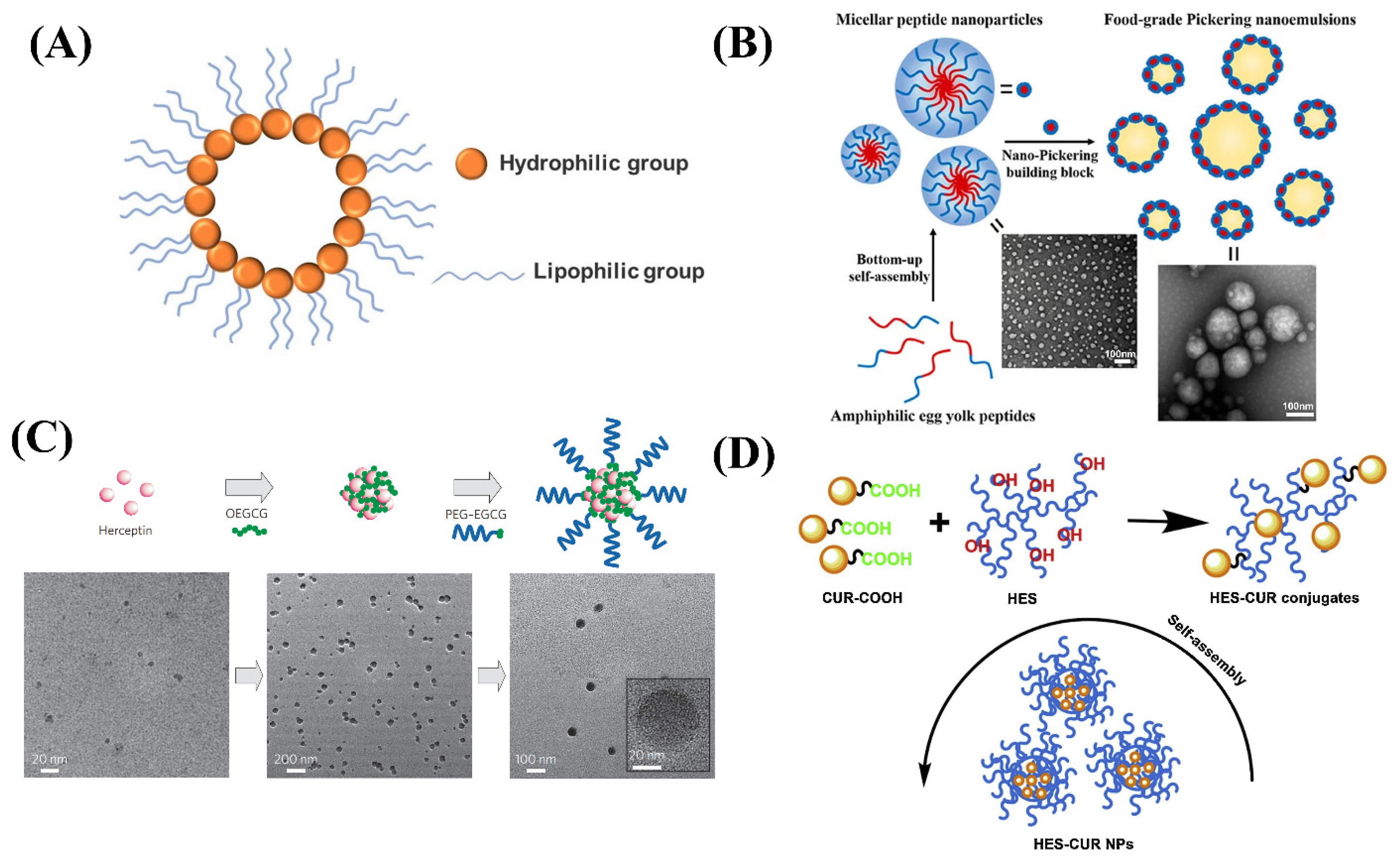
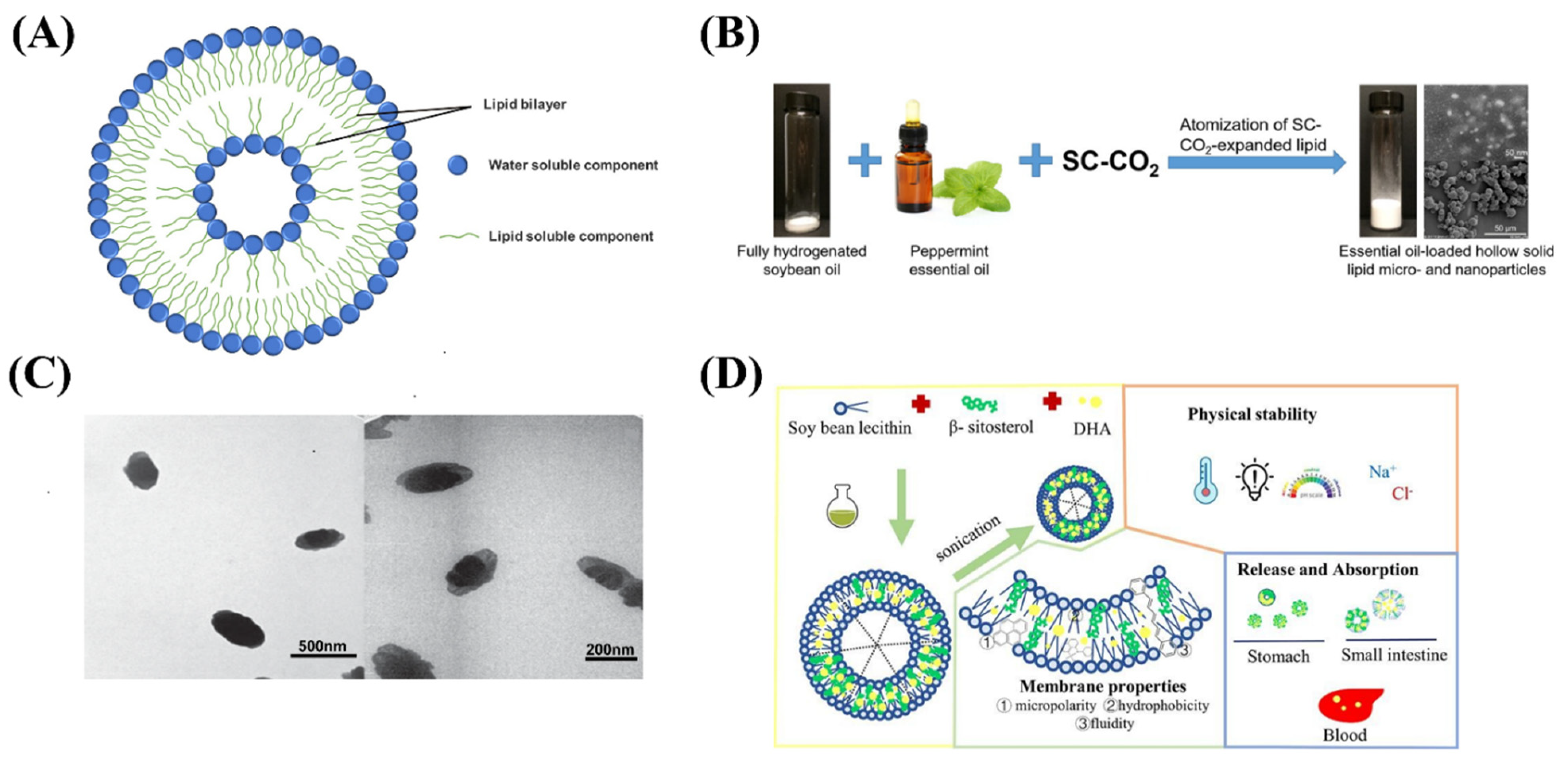
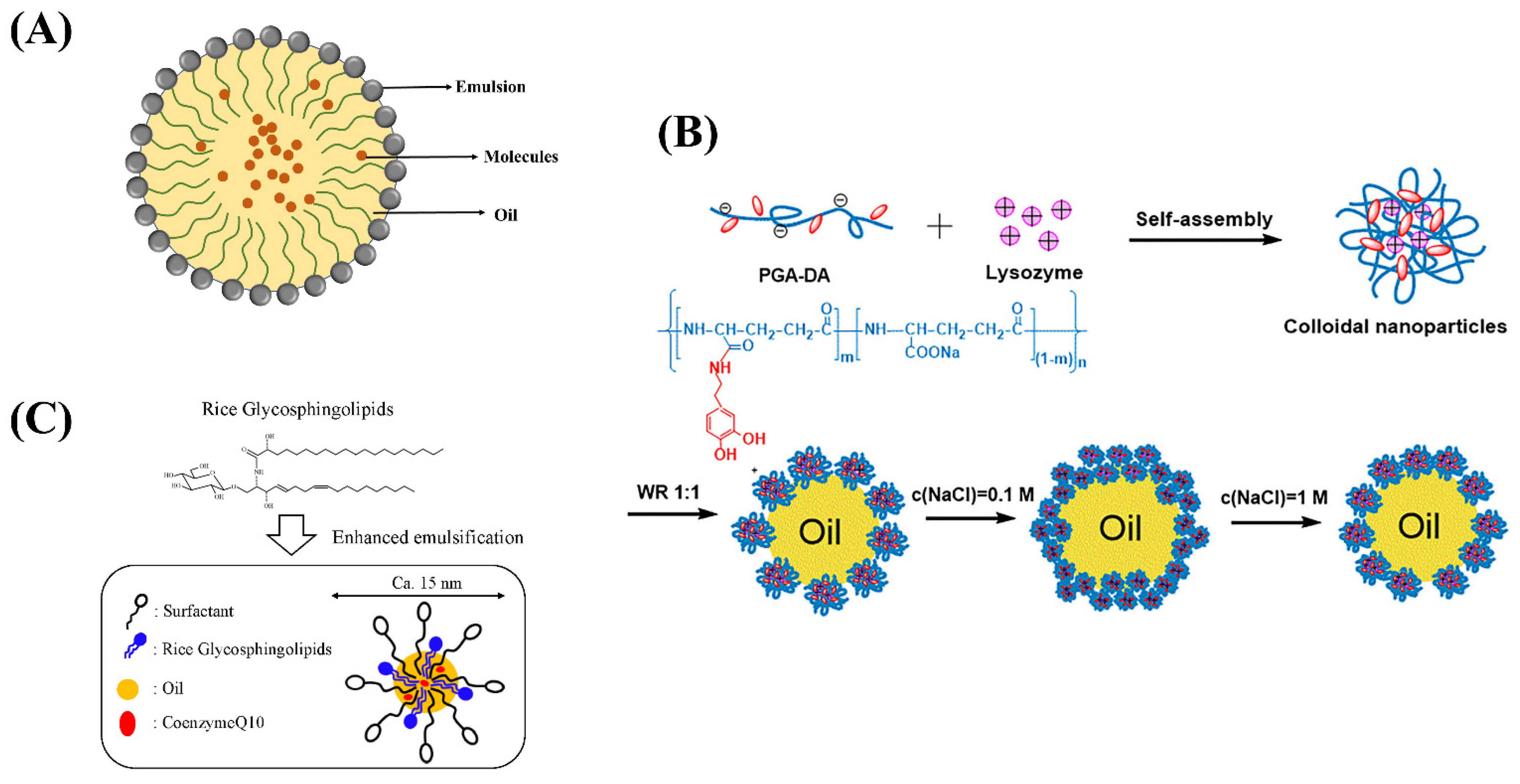
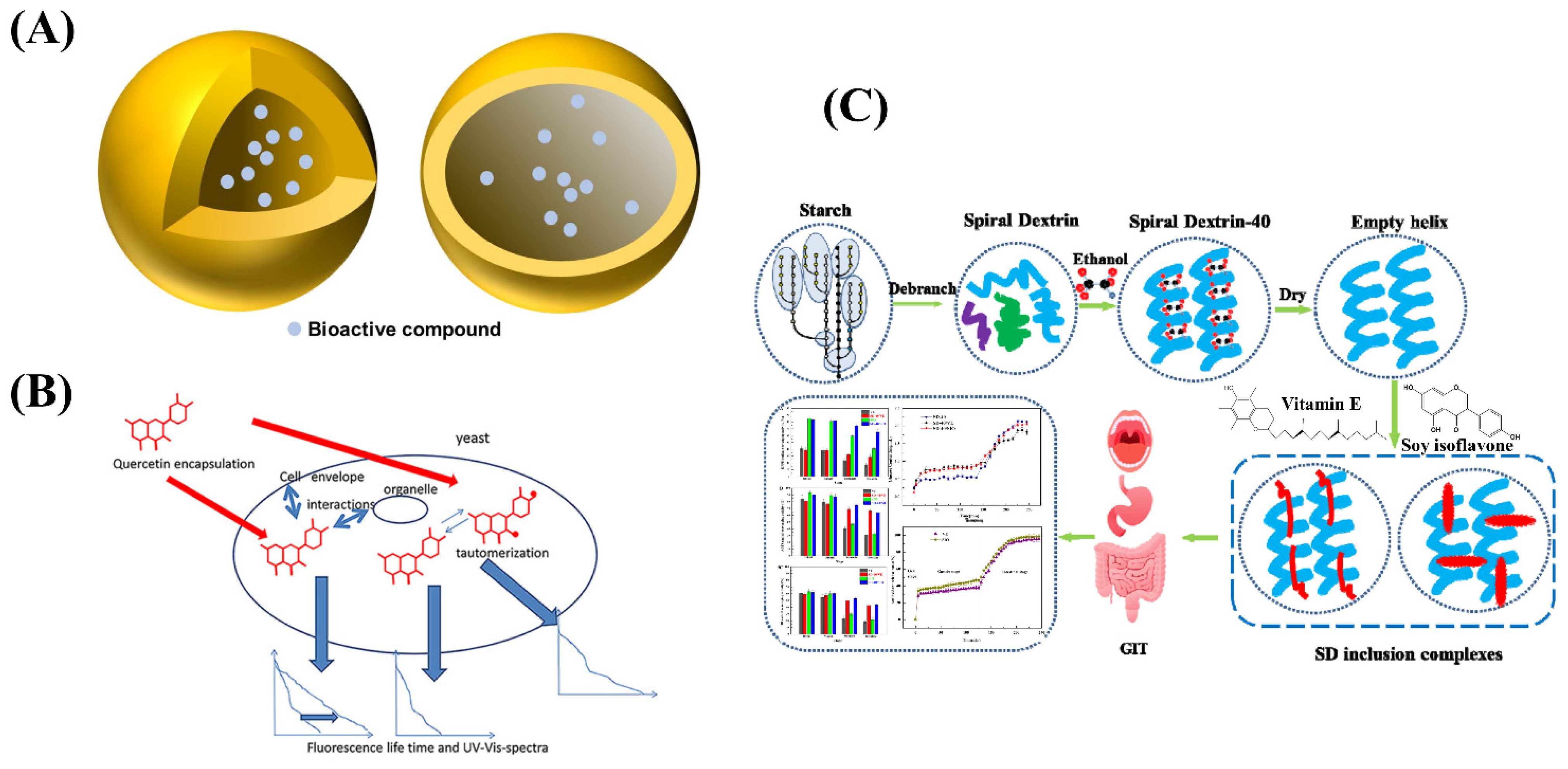
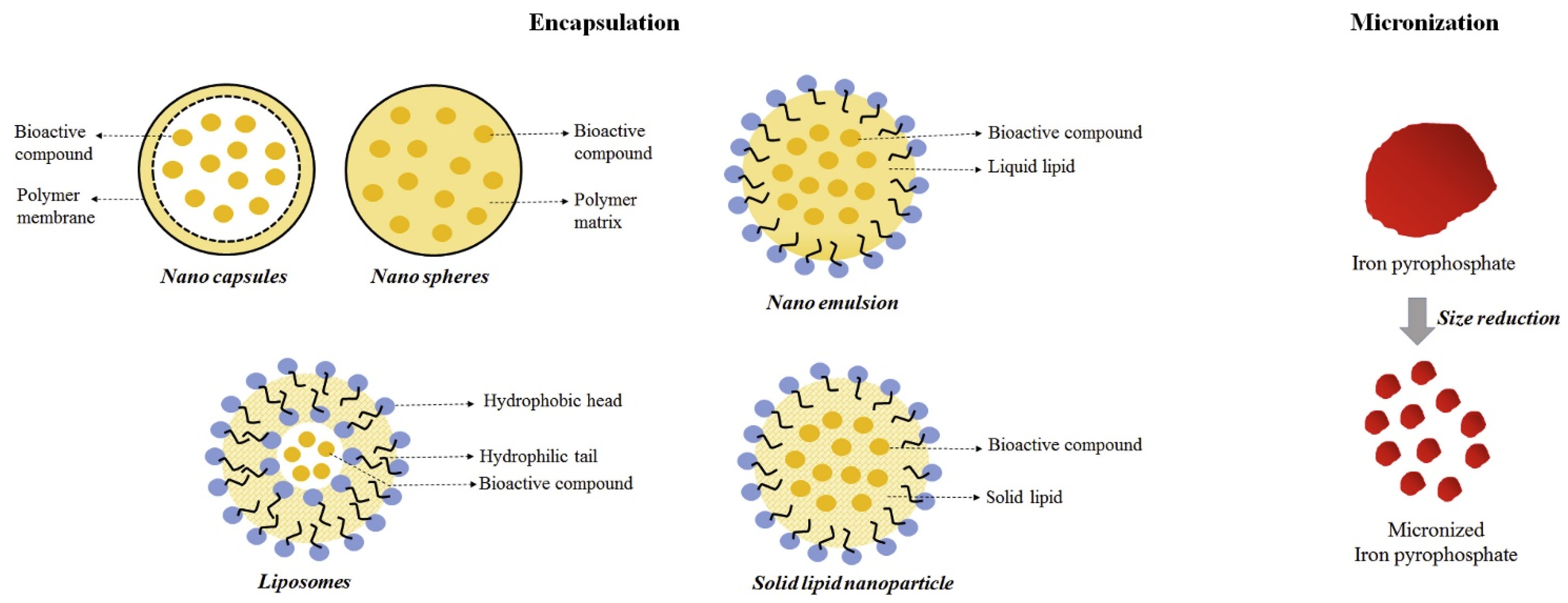
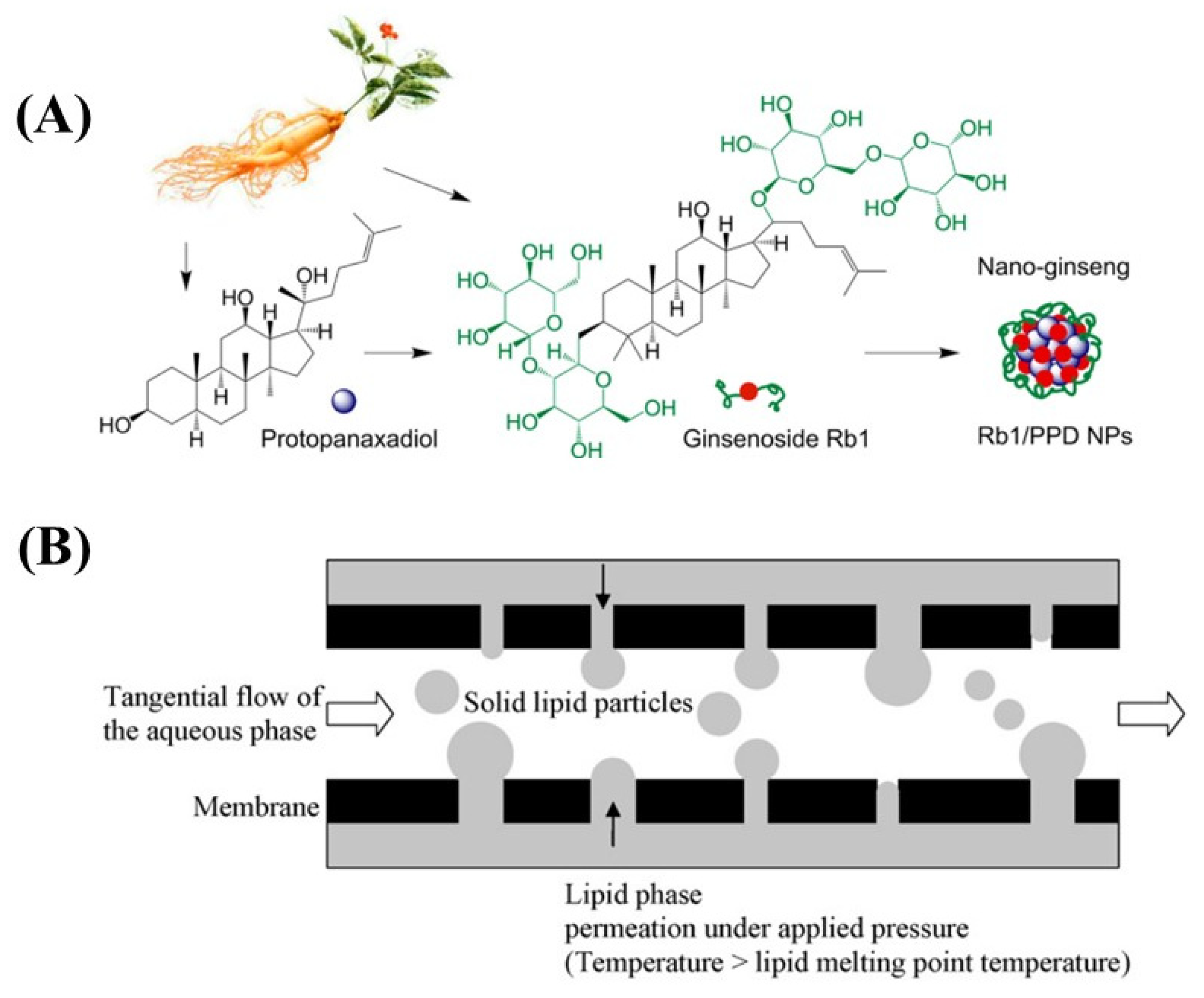
| Materials | Method | Active Components | Size (nm) | Zeta-Potential (mV) | Application | References |
|---|---|---|---|---|---|---|
| Soybean oil | Supercritical fluid technology | Peppermint essential oil | 35.7 | - | Atibacterial agent | [27] |
| Gelucire 50/30 | Spray drying | Lippia sidoides essential oil | 525.3 | −25.9 | Encapsulates essential oils | [28] |
| Palmitic acid, lecithin | Micro-emulsion method | Anthocyanin | 455 | - | Antioxidant | [29] |
| Lecithin | Ultrasonic emulsification | Astaxanthin | 94 | - | Food additives | [30] |
| Lecithin | Hot homogeneous method | Vitamin B12 | 200 | −5.28 | Anti-cancer drug | [31] |
| Soybean lecithin | Sonication method | DHA | 130 | - | Food stabilizers | [32] |
Disclaimer/Publisher’s Note: The statements, opinions and data contained in all publications are solely those of the individual author(s) and contributor(s) and not of MDPI and/or the editor(s). MDPI and/or the editor(s) disclaim responsibility for any injury to people or property resulting from any ideas, methods, instructions or products referred to in the content. |
© 2023 by the authors. Licensee MDPI, Basel, Switzerland. This article is an open access article distributed under the terms and conditions of the Creative Commons Attribution (CC BY) license (https://creativecommons.org/licenses/by/4.0/).
Share and Cite
Su, Q.; Zhao, X.; Zhang, X.; Wang, Y.; Zeng, Z.; Cui, H.; Wang, C. Nano Functional Food: Opportunities, Development, and Future Perspectives. Int. J. Mol. Sci. 2023, 24, 234. https://doi.org/10.3390/ijms24010234
Su Q, Zhao X, Zhang X, Wang Y, Zeng Z, Cui H, Wang C. Nano Functional Food: Opportunities, Development, and Future Perspectives. International Journal of Molecular Sciences. 2023; 24(1):234. https://doi.org/10.3390/ijms24010234
Chicago/Turabian StyleSu, Qijun, Xiang Zhao, Xin Zhang, Yan Wang, Zhanghua Zeng, Haixin Cui, and Chunxin Wang. 2023. "Nano Functional Food: Opportunities, Development, and Future Perspectives" International Journal of Molecular Sciences 24, no. 1: 234. https://doi.org/10.3390/ijms24010234
APA StyleSu, Q., Zhao, X., Zhang, X., Wang, Y., Zeng, Z., Cui, H., & Wang, C. (2023). Nano Functional Food: Opportunities, Development, and Future Perspectives. International Journal of Molecular Sciences, 24(1), 234. https://doi.org/10.3390/ijms24010234








